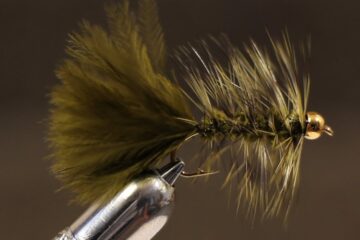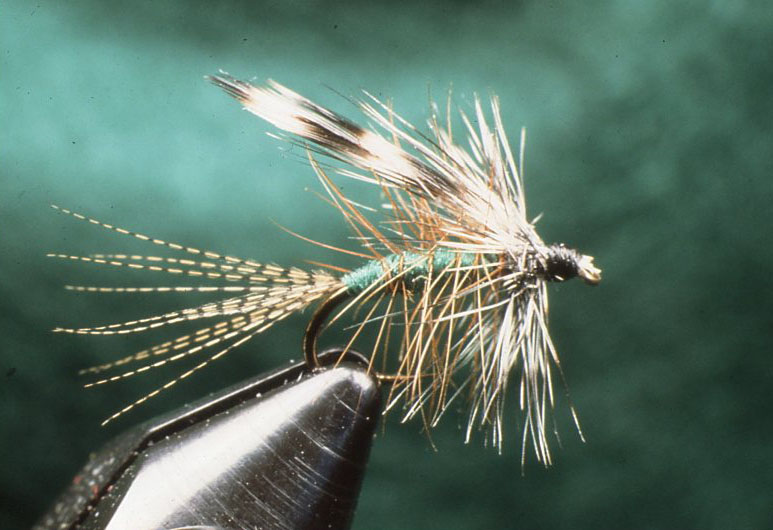What is the greatest Bass fly? Read on and you decide.
Murdich Minnow
Let’s start with the Murdich Minnow. It is a good go to and you can tie it yourself.
The following is an excerpt from Hatch magazine. To read the full article Fishing The Murdich Minnow For Smallmouth Bass by George Daniel, click here.
“FLY CONSTRUCTION
I use a Tiemco 8089 streamer hook in sizes 6-10, but any streamer hook will work. Before attaching thread, I’ll add 8-12 wraps of .015-.025 lead wire around the lower third of the bend to act as a keel. The keel keeps the hook riding hook point down and provides more momentum for the pattern to glide during the pause between strips. A few drops of superglue are applied to lock in the lead wire.
The diameter of lead wire depends on how deep you want to fish the pattern. My preference is for .015 to keep the pattern light and neutrally buoyant. The one thing I’m finding out about smallmouth is many of the strikes occur during the pause as the fly hangs in the water column. A heavy fly that quickly drops in front of an interested bass often seems to be a turnoff more than an attraction. I also like long pauses between strips and a heavy fly tends to snag bottom during such long-pause retrieves.
.
Bucktail forms the foundation for the flashy tail and a liberal amount of pearl flashabou strands are laid on top of the deer hair. The stiff tail acts as a rudder, creates buoyancy, and prevents the flashabou tail from fouling around the hook shank. The amount of flash used depends on how much bling you want in the presentation. I’ll add a liberal amount of flash at the tying table but can easily thin out with scissors on the stream. It’s easier to trim flash than to add it streamside. Make sure to tie in the bucktail so the hair doesn’t flash off the sides when applying thread. What you’re looking for is a tight bunch of bucktail tip fibers clumped together. Use light thread wraps at first to keep the hair from flaring and then add additional pressure to lock in the bucktail fibers.
Some fly tiers add a small rattle on the rear hook shank. I may use rattles early in the season when dealing with higher and off-color water, but I rarely use them from late spring to summer. The rattle does add bulk to the rear shank, which is part of the design, where there’s a bulge near center-between the tail and head. This bulge can be constructed of any number of materials, but a pinch of synthetic fiber doubled over and tied back on both sides is a popular choice, which aids in causing the fly to kick sideways during the presentation. The rest of the body is usually an Estaz chenille in size Grande. If desired, stick-on eyes can be applied.
White is my most productive color but sharpie markers can be used to color the pattern. I like the visibility of white in the water and will set the hook when I see the white disappear. Smallmouth tend to inhale (not grab) the fly while swimming towards you. Watching the fly disappear is often a quicker indicator to set the hook than waiting to feel the tug. Always make sure to debarb your hook as bass tend to take the fly deep.
PRESENTATION
A floating or slow intermediate line are my two favorite lines for presenting this neutrally buoyant streamer. Leader formula is a simple two-part system: Half 20-25 lb and half 12-15 lb. I’ll use an 8-9’ leader with my floating line during extreme low flows and a 6-8’ leader when using an intermediate line. Because I employ long pauses, a loop knot provides more movement between strips. For bass, I most often use a short powerful strip (approximately 1-3”), followed by a long pause (3-10 seconds) between strips. The pause allows the Murdich to glide off to the side and then course correct itself. This isn’t usually a 90-degree kick but more like a 45 — just enough to provide any following predator a side view, hopefully enticing a T-bone strike.
The biggest challenge for a trout angler learning to fish for smallmouth is the long pause between strips. Be patient. Watch a three to four foot area around the streamer during the retrieve and pay attention to the fish’s body language. Often, you’ll see bass starting to follow the streamer from a distance only to turn away when the pattern is retrieved too fast or erratically. Think of fishing the Murdich the same way you’d fish a hopper pattern—a long drift with a few twitches. This approach best imitates a wounded or dying baitfish—an easy meal for any predator.”
Chocklett’s Gamechanger Fly

Next, is Chocklett’s Gamechanger fly. Clicking on a link for this fly, I fell out of my chair when I saw the price. $18.44! Purchased online, it is supplied by Umpqua Feather Merchants. The price of the fly causes me to climb upon my soapbox however. For $18.44, it should be able to tie itself onto the tippet and catch every bass that even looks at it.
The flies are not tied in the USA by some veteran who needs the money, nor by the family trying to put their kids through college. They are tied in one of four countries: Africa, southeast Asia, China or South Asia (India, Pakistan, Bangladesh, etc.).
When bass fishing, you are essentially chucking into wood and rocks. You will lose the $18.44 at some point unless you figure out how to make the fly unstick itself from weeds and woody debris. The price of fly fishing is fast approaching, or perhaps crossed into, the elite price of golf. (An example of that is the $150 per round of golf these days.)
Look at rods. Sage is selling their latest and greatest rod for around $1,350, the new Winston Air 2 saltwater rods costs $1,195 and Orvis Helios goes up to $2,225. Where will this end? I don’t know of any tariffs on fly fishing gear, and have never been dinged by Hardy for gear from England. Plus the people who tie these flies are certainly not being paid a living wage.
I understand the fly shop market. The shop buys flies for something like $4.20 per fly. The markup can be high (50-100%). I don’t begrudge the shop making a profit, they need to in order to stay in business. I do begrudge Umpqua and many other fly fishing marketers. If this doesn’t stop, fly fishers will literally be priced out of the sport.
Wooly Bugger

Want to be thrifty? A good old Wooly Bugger is tried and true. They are inexpensive, easy to tie, and available in different color choices. I use brown and green so they look like a crawfish or leech.
Tight lines! – Tom

